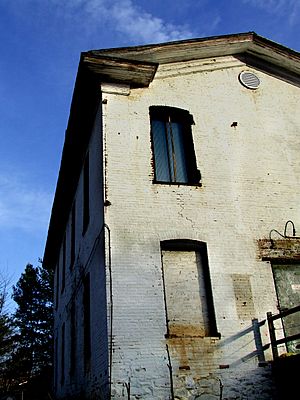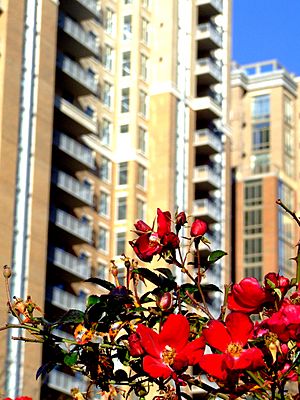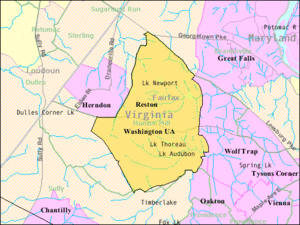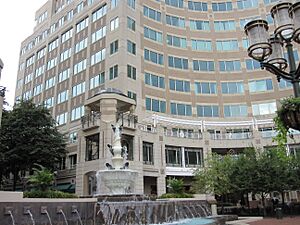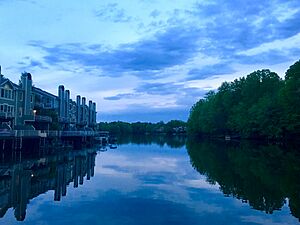Reston, Virginia facts for kids
Quick facts for kids
Reston, Virginia
|
|
|---|---|

Reston Town Center
|
|
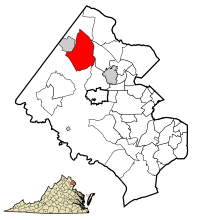
Location of Reston in Fairfax County, Virginia
|
|
| Country | United States |
| State | Virginia |
| County | Fairfax |
| Founded | April 10, 1964 |
| Founded by | Robert E. Simon |
| Area | |
| • Total | 15.7 sq mi (40.6 km2) |
| • Land | 15.3 sq mi (39.7 km2) |
| • Water | 0.3 sq mi (0.9 km2) |
| Elevation | 360 ft (110 m) |
| Population
(2020)
|
|
| • Total | 63,226 |
| • Estimate
(2023)
|
66,070 |
| • Density | 4,130/sq mi (1,593/km2) |
| Demonym(s) | Restonian |
| Time zone | UTC−5 (Eastern (EST)) |
| • Summer (DST) | UTC−4 (EDT) |
| ZIP Codes |
20190, 20191, 20194
|
| Area code(s) | 703, 571 |
| FIPS code | 51-66672 |
| GNIS feature ID | 1499951 |
Reston is a special community in Fairfax County, Virginia, United States. It's a major part of both Northern Virginia and the wider Washington metropolitan area. In 2020, about 63,226 people lived in Reston.
Reston was started in 1964. Its design was inspired by the "Garden City movement." This idea focuses on creating towns that have lots of green spaces, homes, and businesses all mixed together. The founder, Robert E. Simon, wanted to build a town that would change how suburbs were developed after World War II.
In 2018, Money magazine called Reston one of the "Best Places to Live in Virginia." Reston is famous for its many parks, lakes, golf courses, and walking trails. It also has Reston Town Center, a popular place with shops and restaurants.
Contents
History of Reston
How Reston Began
Reston was designed as a planned community by Robert E. Simon. He founded it on April 10, 1964, which was his 50th birthday. The town was named after his initials. It was one of the first modern planned communities in America after World War II. Simon used money from selling Carnegie Hall to create Reston.
He hired architects to plan the town. They made sure there were different types of housing to save open spaces. They also planned areas for businesses, recreation, schools, and homes all in one place.
The first part of Reston built was Lake Anne Plaza. It was designed to look like the Italian coastal town of Portofino. Lake Anne village has modern buildings, an elementary school, and two churches. You can also find an art gallery, restaurants, the Reston Historic Trust Museum, and shops there. Only local businesses are allowed in Lake Anne. Nearby are unique cubist townhouses designed by architect Charles M. Goodman. Later, other parts of Reston like Hunters Woods and South Lakes were developed. Each of these areas has its own shopping center.
Land History of Reston
The land where Reston now stands was once owned by Lord Fairfax in the 1700s. Later, in the 1880s, C.A. Wiehle bought the land. After he passed away, his sons sold the land to A. Smith Bowman. Bowman built a bourbon distillery there and used most of the 7,300-acre (30 km2) area as a farm. Today, a road and a business area are named after him. In 1961, Robert E. Simon bought most of this land. The Bowman distillery kept operating on 60 acres (240,000 m2) until 1987.
Reston's Growth and Changes
Many newspapers and magazines have followed Reston's growth. In 1967, Lady Bird Johnson, the First Lady, visited Reston. She walked along its paths because she was interested in making places more beautiful. Even Apollo 11 astronauts Neil Armstrong and Buzz Aldrin visited elementary schools named after them in Reston.
In the late 1970s and early 1980s, Reston grew a lot. This caused more traffic. The Dulles Toll Road opened in 1984, which helped with traffic. Then, in 1986, the Washington Metro subway system reached West Falls Church. More recently, the Fairfax County Parkway was opened.
Reston has become what is called an "edge city." This means it's a large center of jobs and businesses outside of a main city. However, Reston's careful design helped it avoid common problems of edge cities. For example, it has good places for walking and public transportation.
Reston's Location
Reston is in the northern part of Fairfax County. It is located at 38°57′16″N 77°20′47″W / 38.95444°N 77.34639°W. Nearby communities include Great Falls to the north and the town of Herndon to the west.
The Reston area covers about 15.7 square miles (40.6 km2). Most of this is land (15.3 square miles (39.7 km2)), and a small part is water (0.35 square miles (0.9 km2)). Reston has four man-made lakes: Lake Anne, Lake Audubon, Lake Newport, and Lake Thoreau. Another lake, Lake Fairfax, is partly in Reston but is a county park.
People in Reston
| Historical population | |||
|---|---|---|---|
| Census | Pop. | %± | |
| 1970 | 5,722 | — | |
| 1980 | 36,407 | 536.3% | |
| 1990 | 48,556 | 33.4% | |
| 2000 | 56,407 | 16.2% | |
| 2010 | 58,404 | 3.5% | |
| 2020 | 63,226 | 8.3% | |
| 2023 (est.) | 66,070 | 13.1% | |
| 2020 Census Data | |||
Population in 2020
| Race / Ethnicity | Pop 1980 | Pop 2000 | Pop 2010 | Pop 2020 | % 1980 | % 2000 | % 2010 | % 2020 |
|---|---|---|---|---|---|---|---|---|
| White alone (NH) | 30,834 | 38,563 | 36,952 | 37,666 | 84.69% | 68.37% | 63.27% | 59.57% |
| Black or African American alone (NH) | 3,579 | 5,017 | 5,467 | 5,803 | 9.83% | 8.89% | 9.36% | 9.18% |
| Native American or Alaska Native alone (NH) | 82 | 102 | 99 | 57 | 0.23% | 0.18% | 0.17% | 0.09% |
| Asian alone (NH) | 773 | 5,408 | 6,328 | 7,058 | 2.12% | 9.59% | 10.83% | 11.16% |
| Pacific Islander alone (NH) | 6 | 20 | 22 | 27 | 0.01% | 0.04% | 0.04% | 0.04% |
| Some Other Race alone (NH) | 187 | 205 | 425 | 0.33% | 0.35% | 0.67% | ||
| Mixed Race/Multi-Racial (NH) | N/A | 1,411 | 1,852 | 3,518 | N/A | 2.5% | 3.17% | 5.56% |
| Hispanic or Latino (any race) | 837 | 5,699 | 7,479 | 8,672 | 2.30% | 10.10% | 12.81% | 13.72% |
| Total | 36,407 | 56,407 | 58,404 | 63,226 | 100.00% | 100.00% | 100.00% | 100.00% |
Reston's Economy
Reston is a hub for "professional, scientific, and technical services." This means many companies here offer expert help in fields like science and technology. In 2007, 757 companies in this sector employed over 21,575 people. The information sector is also very important, with 150 companies and nearly 10,000 employees.
Reston is part of the Dulles Technology Corridor. Many well-known companies have offices or headquarters here.
- Bechtel
- CACI
- Caliburn International
- Carahsoft
- Comscore
- ICF International
- Leidos
- Maximus
- Rolls-Royce North America
- Science Applications International Corporation
- NII
- NVR
- Noblis
- Revature
- Verisign
- Learning Tree International
- United States Geological Survey
- National Wildlife Federation
- American College of Radiology
- CNRI
- Google Federal Services
- Gate Group's North American division
- General Dynamics
- Siteworx
- Volkswagen Group of America
Reston is also important for venture capital. Five of the 20 largest venture capital firms in the Washington, D.C. area are in Reston. These firms manage billions of dollars to invest in new businesses. The North American command for the German armed forces is also based in Reston.
Arts and Fun in Reston
Reston has a special tax district that helps fund fun activities. The Reston Community Center (RCC) is a big part of this. Its main building has a theater, an indoor pool, meeting rooms, and classrooms. There's also a smaller RCC branch at Lake Anne Plaza.
Reston is home to several performing arts groups. The Reston Community Players have been performing since 1966. The Reston Chorale is a mixed-voice chorus that started in the late 1960s. The Reston Community Orchestra also performs regularly. In the summer, you can enjoy free outdoor concerts at Reston Town Center and Lake Anne Plaza.
The Greater Reston Arts Center (GRACE) is located at Reston Town Center. It hosts the yearly Northern Virginia Fine Arts Festival. The Reston Art Gallery at Lake Anne Plaza shows art and has artist studios.
The only museum in Reston is the Reston Historic Trust & Museum at Lake Anne Plaza. It has maps, photos, and books that show Reston's history since the 1960s. The Washington West Film Festival is an autumn event in Reston. It shows many feature films, short films, and documentaries.
Fun Events in Reston
- Northern Virginia Fine Arts Festival (Reston Town Center) (May)
- Taste of Reston Food Festival (Reston Town Center) (June)
- Reston Triathlon (September)
- Reston Multicultural Festival (Lake Anne Plaza) (late September)
- Flavors of Fall (Reston Town Center) (October)
- Reston Holiday Parade (Reston Town Center) (November)
Parks and Recreation
Robert Simon, Reston's founder, wanted to save green spaces and offer fun activities. Reston has over 55 miles (88 km) of walking and hiking paths. About 250 acres (1 sq km) of woodlands and open space are preserved. Reston is known for its many trees, which cover about half of the town. It's one of only eight places in the U.S. that belongs to the Biophilic Cities Organization. This group promotes protecting nature in cities.
The Vernon J. Walker Nature Education Center is a key natural spot. Its 72 acres (290,000 m2) of forest have picnic areas and facilities for outdoor programs. The Nature House has exhibits and programs for kids.
Reston has two golf courses. The Reston National Golf Course is certified as a Cooperative Sanctuary. The Hidden Creek Country Club was bought by a real estate company in 2017.
The Washington and Old Dominion (W&OD) trail goes through Reston. This 45-mile-long (72 km) path is just for walking and biking.
Reston has four man-made lakes: Lake Anne, Lake Audubon, Lake Newport, and Lake Thoreau. Lake Fairfax Park, a 476-acre (1.9 km2) county park, is also in the area. It offers boat rentals, a large outdoor pool called "The Water Mine," and picnic spots.
A 30-acre (120,000 m2) zoo, NOVA Wild, is on the northeast side of Reston. It offers family-friendly animal interactions. You can see animals like lambs, camels, zebras, antelope, bison, cheetah, emu, goats, reptiles, horses, and waterfowl.
Reston has several pools, including an indoor pool at the Reston Community Center. You can ice skate year-round at SkateQuest, an indoor rink. In winter, there's an outdoor rink at Reston Town Center.
Education in Reston
Schools for Kids and Teens
Reston is part of the Fairfax County Public Schools system. It also has several private schools. South Lakes High School serves most of Reston. Next to it is Reston's only middle school, Langston Hughes Middle School. Some students in northern Reston attend Herndon High School.
Public Elementary Schools:
- Buzz Aldrin Elementary School
- Neil Armstrong Elementary School
- A. Scott Crossfield Elementary School
- Dogwood Elementary School
- Forest Edge Elementary School
- Fox Mill Elementary School
- Hunters Woods Elementary School for the Arts and Sciences
- Lake Anne Elementary School
- Sunrise Valley Elementary School
- Terraset Elementary School
Private Schools:
- Children's House Montessori School of Reston
- Community Montessori School
- Reston Montessori School
- Academy of Christian Education (elementary)
- Edlin (elementary and middle school)
- United Christian Parish Preschool
- Lake Anne Nursery and Kindergarten (LANK)
- Ideaventions Academy for Math and Science (4th - 12th)
- Reston Children's Center (RCC)
Colleges and Universities
Reston offers several options for higher education. These include a campus of Northern Virginia Community College (NVCC), the University of Phoenix – Northern Virginia campus, and Marymount University – Reston Center.
Libraries in Reston
The Fairfax County Public Library system runs the Reston Regional Library. Reston also has the United States Geological Survey Library. This is a federal research library open to the public. It holds over 3 million items, including books, journals, maps, and photos.
Media and News
Reston mostly gets its news from the Washington, D.C. area. Local newspapers include The Washington Post and The Washington Times. There are also local publications like the Fairfax Times and the Reston Connection. All of these offer online news. The website Reston Now provides daily local news coverage. Many TV and radio stations in the Washington area also cover local events.
Getting Around Reston
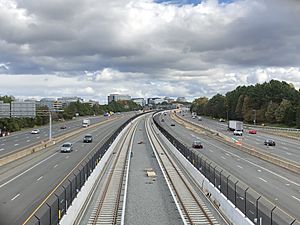
Reston is located along the Dulles Toll Road. It's about 9 miles (14 km) from Tysons and the Capital Beltway to the east. It's also about 5 miles (8.0 km) from Washington Dulles International Airport to the west. Four main roads cross Reston from north to south: Fairfax County Parkway, Reston Parkway, Wiehle Avenue, and Hunter Mill Road.
The Metro's Silver Line runs along the Dulles Toll Road. The first Reston station, Wiehle-Reston East, opened on July 26, 2014. Two more stations, Reston Town Center and Herndon, opened on November 15, 2022. These stations serve the western part of Reston and connect to the airport.
The Reston Internal Bus System (RIBS) has five bus routes. These routes connect Reston's village centers, using Reston Town Center as a main stop. Fairfax County's Fairfax Connector and Metrobus also connect people in Reston to Metro stations and other places in Fairfax County.
Interesting Facts and Awards
Many articles and journals have studied Reston's growth. In 1967, First Lady Lady Bird Johnson visited Reston to see its pathways. Apollo 11 astronauts Neil Armstrong and Buzz Aldrin visited elementary schools named after them. The Washington Post featured a road trip to Reston in 2006.
The American Institute of Certified Planners recognized Reston and Robert Simon. They praised Simon's idea of having fields and trees throughout the community. They called Reston "one of the finest examples of American 20th century conceptual new town planning."
In 2017, the Lake Anne Village Center's historic district was added to the National Register of Historic Places. This list includes important places that should be protected.
Reston is one of the few communities in the U.S. to be named a Backyard Wildlife Habitat community. This means it helps protect local wildlife.
Reston generally follows "new urbanism" ideas. This means it has a good path system and mixed-use areas. However, some parts of Reston are different from typical new urbanism. For example, some buildings face away from main streets. Also, some major roads don't have full sidewalks. This is because Fairfax County controls Reston's transportation planning.
Notable People from Reston
- Donna Andrews, author
- Maame Biney, former speed skater, competed in the 2018 Winter Olympics and 2022 Winter Olympics
- Roy Buchanan, blues musician and guitarist
- Grant Hill, former professional basketball player
- Lubomir Kavalek, chess grandmaster
- Jacob Sartorius, pop singer
- Alan Webb, track and field athlete, former U.S. record-holder for mile run
See also
 In Spanish: Reston (Virginia) para niños
In Spanish: Reston (Virginia) para niños





